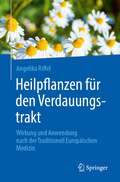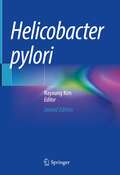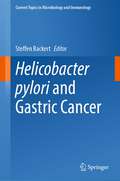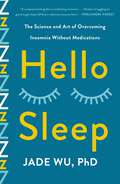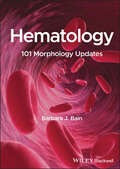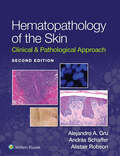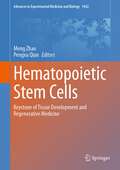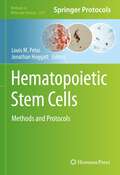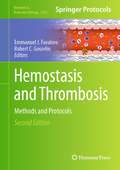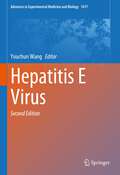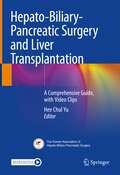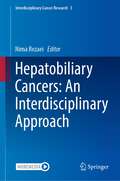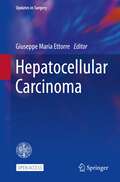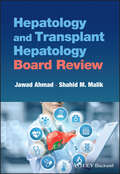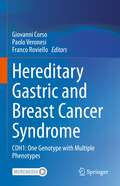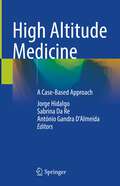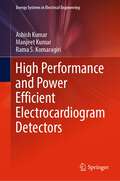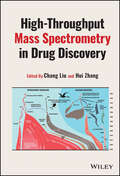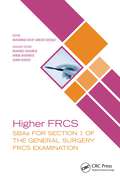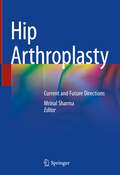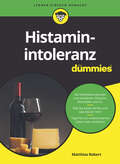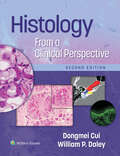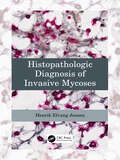- Table View
- List View
Heilpflanzen für den Verdauungstrakt: Wirkung und Anwendung nach der Traditionell Europäischen Medizin
by Angelika RiffelNach dem großen Erfolg des Buches "Heilpflanzen der Traditionellen Europäischen Medizin", in dem der Einsatz von Heilpflanzen für eine Vielzahl von Indikationen vorgestellt wird, beschreibt die Autorin nun in einem neuen Band, wie sich heimische Heilpflanzen positiv auf den Verdauungsapparat auswirken können. Ein kurzer Grundlagenteil führt zu Beginn in die Traditionelle Europäischen Medizin (TEM) im Gastrointestinaltrakt ein. Der weitaus größere Teil bietet eine gute Übersicht, welche Heilpflanzen bei welcher Indikation auf den Magen-Darm Trakt wirken, wobei nach Krankheitsbild geordnet die jeweiligen Heilpflanzen in Wort und Bild mit ihrer Wirkung, Anwendung und Zubereitungsmöglichkeit vorgestellt werden. Ein eigenes Kapitel geht auf die Bedürfnisse von Kindern ein. Das praxisnahe Buch wendet sich an alle Personen, die sich mit der TEM beschäftigen und mehr über heimische Heilpflanzen für den Verdauungsapparat erfahren möchten.
Helicobacter pylori
by Nayoung KimThis book presents the current state of knowledge regarding the ability of Helicobacter pylori to colonize the gastrointestinal tract, the global epidemiology of H. pylori infection, transmission routes, the pathophysiology of H. pylori-related gastroduodenal and other diseases, diagnosis and treatment methods, guidelines for eradication, antibiotic resistance, the reinfection and recrudescence rate after H. pylori eradication, the effect of H. pylori and its eradication on the gastric microbiota and animal models of H. pylori or related Helicobacter infection. The aim is to equip readers around the world with the understanding required in order to implement effective methods of H. pylori eradication and to enhance clinical outcomes for patients. In addition, readers can understand the interaction between H. pylori and other gut microbiota during chronic infection and after H. pylori eradication. The text is clearly written and is complemented by many helpful illustrations. This book will be a great asset in clinical practice for all practitioners who are involved in caring for patients with H. pylori-related diseases or have an interest in the subject. It will also be a useful source of information for medical students and for intelligent laypeople seeking information on H. pylori.
Helicobacter pylori and Gastric Cancer (Current Topics in Microbiology and Immunology #444)
by Steffen BackertThis volume explores in detail the molecular biology, genetics and immunology of the bacterium Helicobacter pylori that causes serious gastric diseases such as gastric cancer. The book provides in-depth insights into the mechanisms of H. pylori-induced pathogenicity, gives an overview of how the bacterium colonizes the human gut, how it manages to persist in the body and which factors play a role in the development of H. pylori-induced gastric cancer. Furthermore, the interaction between the Gram-negative bacterium and the human gut microbiome is explored, and clinical management and treatment strategies to combat gastric cancer are discussed.Helicobacter pylori is an extremely successful pathogen that persistently colonizes the gut of about 50% of the world’s population. H. pylori and its human host share a long co-evolutionary relationship that dates back for at least last 100,000 years and possibly longer. Infection by this bacterium is a high-risk factor for the development of gastric diseases, including gastric cancer. Gastric cancer is associated with high morbidity and mortality and represents the 5th most common malignant tumour and the 4th leading cause of cancer-related death worldwide. H. pylori is the first bacterium that has been classified as a type-I carcinogen by the International Agency for Research on Cancer (IARC). Recent research progress identified crucial bacterial, host and environmental factors which control H. pylori-induced gastric malignancy. New studies also suggest that specific human germline mutations and other genetic aberrations have an important impact on H. pylori-induced pathology. In this volume, all these recently discovered mechanisms are reviewed in the light of gastric cancer development, and H. pylori epidemiology, virulence factors, immune evasion, pathophysiology, cancer signalling and novel therapeutic protocols are presented. This volume is aimed at researchers in the fields of immunology, genetics, microbiology and medicine who are interested in the detailed mechanisms of the pathogenicity of this carcinogenic stomach bacterium.
Hello Sleep: The Science and Art of Overcoming Insomnia Without Medications
by Jade WuA practical and compassionate guide to repairing your relationship with sleepFor the twenty-five million Americans who struggle with insomnia, each night feels like a battle with their racing minds instead of a blissful surrender into sleep. Hello Sleep is a guide for the tired but wired people who just want sleep to be easy. Dr. Jade Wu, an internationally recognized behavioral sleep medicine specialist, walks you through the science of how the brain sleeps (or doesn’t); shares stories from the clinic of real people’s journeys to better sleep; and lays out a step-by-step program for overcoming insomnia and letting go of sleeping pills. Using her years of clinical expertise, she problem-solves your common pitfalls, soothes your anxieties, and tailors recommendations for your special sleep circumstances (e.g., pregnancy, menopause, chronic pain, depression, etc.). Hello Sleep empowers the sleepless with the latest knowledge and most effective tools, allowing them to trust themselves and their own sleep again. It will answer these burning questions and more:• Why can’t I fall asleep even though I’m tired? How can I quiet my mind?• What should I do when I wake up at 2:00 A.M. and can’t get back to sleep?• Should I nap? What can I do about my fatigue during the day?• How do I get off sleep medications safely and without rebound insomnia?
Hematology: 101 Morphology Updates
by Barbara J. BainHematology Timely morphology resource based on ongoing series of morphology updates published in the American Journal of Hematology since 2008 This is the first book of its kind, written by renowned author Professor Barbara J. Bain, featuring a collection of instructive cases with interesting morphological features initially published in the American Journal of Hematology. This new book aims to bring these interesting and instructive cases to a wider readership. This book features updated cases and a “Test Yourself” section to aid in reader comprehension and information retention. Cases covered in Hematology: 101 Morphology Updates include: The significance of irregularly contracted cells and hemighosts in sickle cell disease, and striking dyserythropoiesis in sickle cell anemia following an aplastic crisis Prominent Howell-Jolly bodies when megaloblastic anemia develops in a hyposplenic patient, and unusual aspects of G6PD deficiency The cause of sudden anemia revealed by the blood film, chorea-acanthocytosis and dysplastic neutrophils in an HIV-positive woman Neutrophil dysplasia induced by granulocyte colony-stimulating factor, and diagnosis of pyrimidine 5'-nucleotidase deficiency suspected from a blood film Hematology: 101 Morphology Updates is a key resource for consultant hematologists and clinical scientists, trainee hematologists and biomedical scientists. The audience may use this book to solve difficult diagnostic problems or as a source of teaching cases: for both personal learning, including exam revision or solving difficult cases, and as a teaching resource.
Hematopathology of the Skin: Clinical & Pathological Approach
by Alejandro A. Gru Andras Schaffer Alistair RobsonThe most comprehensive reference book on diagnosing cutaneous hematologic disorders available, Hematopathology of the Skin: Clinical and Pathological Approach, 2nd Edition, provides interdisciplinary guidance from more than 40 global experts in the fields of dermatopathology, dermatology, hematopathology, and hemato/oncology. Edited by Dr. Alejandro A. Gru, Dr. András Schaffer, and Dr. Alistair Robson, this concise yet comprehensive reference features a logical, consistent format heavily illustrated with high-quality clinical and pathological images throughout. Unparalleled in scope, it is a well-written, easy-to-follow resource for clinicians who care for patients with cutaneous hematologic neoplasms.
Hematopoietic Stem Cells: Keystone of Tissue Development and Regenerative Medicine (Advances in Experimental Medicine and Biology #1442)
by Meng Zhao Pengxu QianThis book renders a comprehensive understanding of hematopoietic stem cells (HSCs) from their embryonic development through adult maintenance to aging, in the studies conducted in zebrafish and mammals. Hematopoiesis provides a paradigm for understanding the development, maintenance, regeneration, aging and malignant transformation of mammalian organs. Sitting at the apex of the hematopoiesis hierarchy tree, HSCs orchestrate their proliferation, self-renewal, and differentiation to produce all the blood cell lineages throughout life, which represents the best example for somatic stem cell studies. In this book, key regulatory mechanisms for HSC self-renewal and differentiation are overviewed in an array of fields including epigenetics, metabolism and microenvironment regulation. It also highlights the HSC heterogeneity and clonal dynamics from the recent advanced single-cell technologies. This book elaborates on the research history of HSC studies and reveals how the insights from HSC studies shed light on their clinic application. It presents great value from the bench to the clinic.
Hematopoietic Stem Cells: Methods and Protocols (Methods in Molecular Biology #2567)
by Louis M. Pelus Jonathan HoggattThis detailed volume collects updates on the technical advances in hematopoietic stem cell research and incorporates new techniques focused on the molecular/genetic, cellular, and whole organism levels. Exploring methods that apply stress to hematopoiesis, the book also contains chapters focused on better understanding the role of hematopoietic niches and their cellular components, as well as in vivo models that test and quantitate stem cell function and are key to further development of therapeutic applications. Written for the highly successful Methods in Molecular Biology series, chapters include introductions to their respective topics, lists of the necessary materials and reagents, step-by-step and readily reproducible laboratory protocols, and tips on troubleshooting and avoiding known pitfalls. Authoritative and up-to-date, Hematopoietic Stem Cells: Methods and Protocols serves as a valued addition to laboratories focused on understanding hematopoietic stem cell biology and the therapeutic advances that can be derived from it.
Hemostasis and Thrombosis: Methods and Protocols (Methods in Molecular Biology #2663)
by Emmanuel J. Favaloro Robert C. GosselinThis second edition volume expands on the previous edition with updates about the latest state-of-the-art techniques used in leading hemostasis and thrombosis laboratories for diagnosis and exclusion of hemorrhagic and thrombotic diseases. The chapters in this book are organized into seven parts. Part One provides a general overview on hemostasis and thrombosis, preanalytical issues in testing, and routine hemostasis assays. Part Two covers laboratory testing for thrombophilia, including reviews for activated protein C resistance, protein C, lupus anticoagulant testing, and antiphospholipid antibodies. Part Three addresses monitoring continuous anticoagulant infusions and measuring the effects of oral anti-thrombotic therapy. Part Four talks about heparin induced thrombocytopenia and vaccine induced immune thrombotic thrombocytopenia. Part Five and Six cover ADAMTS13 activity testing and new information on bleeding disorders such as chromogenic factor VIII assays, measurement of emicizumab, and treatment of hemophilia A and B. Finally, Part Seven discusses global assays, research applications, and postanalytical considerations. Written in the highly successful Methods in Molecular Biology series format, chapters include introductions to their respective topics, lists of the necessary materials and reagents, step-by-step, readily reproducible laboratory protocols, and tips on troubleshooting and avoiding known pitfalls.Cutting-edge and comprehensive, Hemostasis and Thrombosis: Methods and Protocols, Second Edition is a valuable resource for scientists and researchers struggling to identify the appropriate methods for hemostasis and thrombosis testing, or who seek additional expert guidance on such testing.
Hepatitis E Virus (Advances in Experimental Medicine and Biology #1417)
by Youchun WangThis book systematically and comprehensively discusses the biological, epidemiological, and clinical characteristics of the hepatitis E virus (HEV). It presents current knowledge of HEV and explores experimental methods, treatment, and prevention of HEV. First identified in the 1980s and cloned in 1990, HEV is the causative agent of hepatitis E, which mainly occurs in developing regions, such as Southeast Asia, the Middle East, and Africa, and significantly affects the health of the people in these areas. It is estimated that a third of the world’s population has been infected with HEV, which is transmitted via the fecal-oral route and can infect both humans and animals. In the second edition, new chapters are added to demonstrate the lifecycle, morphogenesis, and stem cell culture of hepatitis E virus. Although research on hepatitis E virus has made progress recently, there are still some problems that have not been solved. Those problems are discussed in this edition, which would be helpful for researchers to understand the problems on hepatitis E virus that they have faced. Meanwhile, the epidemiology, transmission, genetic evolution, animal models, treatment, and others in the related chapters of the first version were also updated according to the most recent research progress. The book provides an overview of HEV from benchside to bedside. It is a valuable resource for researchers in the field and those in the pharmaceutical industry developing HEV vaccines, as well as physicians involved in identifying and treating those infected with the virus.
Hepato-Biliary-Pancreatic Surgery and Liver Transplantation: A Comprehensive Guide, with Video Clips
by Hee Chul YuThis book describes and illustrates surgical procedures in the field of hepatobiliary and pancreatic surgery and liver transplantation, including important cutting-edge techniques. Written by master surgeons from the Korean Association of Hepato-Biliary-Pancreatic Surgery, it will be invaluable for all who are embarking on a career in this field or are seeking to improve their surgical skills. The three sections of the book focus on liver surgery, gallbladder and biliary surgery, and pancreatic surgery. A wide range of operative procedures are covered, including different techniques of hepatectomy, deceased and living donor liver transplantation, cholecystectomy, resection of choledochal cysts, procedures appropriate in the contexts of hilar and extrahepatic cholangiocarcinoma, pancreatectomy, and pancreaticoduodenectomy. Attention is drawn to essential tips and tricks, and each chapter includes video clips of the described procedures in addition to high-quality surgical photos and illustrations.
Hepatobiliary Cancers: An Interdisciplinary Approach (Interdisciplinary Cancer Research #3)
by Nima RezaeiHepatobiliary cancers, including hepatocellular carcinoma and biliary tract cancers, have high rate of mortality and low survival rate. The third volume of the “Interdisciplinary Cancer Research” series, entitled “Hepatobiliary Cancers: An Interdisciplinary Approach” publishes comprehensive volumes on mechanisms of hepatobiliary cancers and therapeutic modalities and presents the most updated and peer-reviewed chapters on hepatobiliary cancers. This interdisciplinary series is of special value to researchers working on cell biology, immunology, biochemistry, genetics, and practitioners working on oncology and gastroenterology. This is the main concept of Cancer Immunology Project (CIP), which is a part of Universal Scientific Education and Research Network (USERN). This interdisciplinary book will be of special value for researchers, oncologists, and gastroenterologists who wish to extend their knowledge on hepatobiliary cancers.
Hepatocellular Carcinoma (Updates in Surgery)
by Giuseppe Maria EttorreThis open access book offers a comprehensive review of hepatocellular carcinoma (HCC) with a particular focus on the pathobiology and clinical aspects of the disease, including diagnosis and treatment. HCC is becoming one of the most common causes of cancer-related death worldwide. It is the fifth most common malignancy in men and the ninth in women, with an estimated 500,000 to 1 million new cases annually around the world. Independent of its cause, cirrhosis is considered a major clinical and histopathological risk factor for HCC development. Five percent of all cirrhotic patients develop HCC every year. Diagnostic tools for HCC include blood tests, high-quality imaging studies and liver biopsy. The treatment of HCC depends on the size and location of the HCC and includes surgical resection, liver transplantation, endovascular approaches, percutaneous ablation, and medical treatments. The book is organized into four parts – overview, diagnosis, management strategies, and recommendations – and aims to provide surgeons and clinicians with a valuable resource for complete and up-to-date research on the clinical aspects and management of HCC.
Hepatology and Transplant Hepatology Board Review
by Jawad Ahmad Shahid M. MalikHepatology and Transplant Hepatology Board Review Hepatology and Transplant Hepatology: Board Review with Multiple Choice Questions is the only source you will need to pass the American Board of Internal Medicine (ABIM) transplant hepatology examination. Written by two highly experienced hepatologists, this indispensable study guide covers all the main topics tested on the exam: pre-transplant, perioperative, post-transplant, and transplant immunology. 261 multiple-choice questions with answers, including questions based on the authors’ real-life cases, are designed to mimic the clinical scenarios you will encounter in hepatology practice. Questions testing your medical knowledge, clinical insight, and management skills are supported by brief topic overviews, key references, high-quality images, pathology slides, and cholangiograms. Throughout the book, “Pearls” and “Must-Know Facts” sections emphasize testable points that are likely to appear on the ABIM board examination. The first hepatology-specific study aid of its kind, Hepatology and Transplant Hepatology: Board Review with Multiple Choice Questions is a must-have for medical professionals preparing for the hepatology boards, as well as practicing gastroenterologists and hepatologists who want to refresh their knowledge and test their proficiency in both fundamental and advanced hepatology topics.
Hereditary Gastric and Breast Cancer Syndrome: CDH1: One Genotype with Multiple Phenotypes
by Franco Roviello Giovanni Corso Paolo VeronesiIn this book the editors and authors provide a comprehensive overview on basic research and clinical aspects of hereditary breast and gastric tumors. In particular, this updated editorial work aims to suggest guidelines for the clinical management of patients with hereditary diffuse gastric and lobular breast cancer. Special attention is given to E-cadherin (CDH1 gene) germline mutations, genetic screening approaches, the underlying molecular mechanisms and pathological and microscopic features. In addition, the book aims to define clinical criteria for genetic screening, and highlights current surgical treatment and clinical approaches for asymptomatic mutation carriers. Other inherited predispositions involving gastric and breast carcinoma are discussed as well. Divided into eight sections, the book starts by providing an epidemiological overview of gastric and breast cancers, followed by a section dealing with new descriptions of genetic pathways in hereditary cancer predispositions. The third section focuses on pathological features of the diseases, in an effort to bridge the gap between discovery and cancer therapy development. Subsequent sections of the book are dedicated to endoscopy and breast imaging, as well as risk-reducing surgeries to curb the risk of developing cancer. The sixth section focuses on the generation of ideas for the identification of targets and novel treatment strategies. Finally, in the seventh section the authors share the story of two patients and their experiences with the diagnosis and treatment of hereditary cancer.This multidisciplinary book brings together multiple disciplines in science and technology; specifically, medicine, surgery and biology. The majority of authors are members of the International Gastric Cancer Linkage Consortium (IGCLC) and of the European Cancer Prevention Organization (EJCPO), with relevant experience in this context. Offering in-depth insights into hereditary cancers, this book represents essential reading for students, researchers, and specialists who want to extend their knowledge on hereditary gastric and breast cancers.
High Altitude Medicine: A Case-Based Approach
by Jorge Hidalgo Sabrina Da Re António Gandra D’AlmeidaHigh-altitude illness is a collective term for a cluster of acute clinical syndromes that directly consequence from rapid ascent to high altitude, viz., above 2500 m. The acute syndromes affecting the brain include acute mountain sickness (AMS) and high-altitude cerebral edema (HACE). The current practice of high altitude medicine requires a deep knowledge of existing evidence. However, knowledge of the field is continuously evolving, and there are many gaps in the existing literature as well as areas of controversy despite existing research in the area. Each chapter begins with a real case from the author's clinical practice. After each case, a question is asked to allow the reader to reflect on clinical management before reading the answer and consolidating knowledge from experts in the field. They also focus on the standard practice of management and diagnosis, emphasizing evidence-based care when available as well as areas of uncertainty and active debate in the medical literature.Written by experts in the field, High Altitude Medicine offers the most up-to-date knowledge about high altitude medicine that is not only useful for physicians at high altitude dedicated centers but also medical providers at different levels of their careers, especially emergency and urgent care physicians who are the ones that initially see the patient.
High Performance and Power Efficient Electrocardiogram Detectors (Energy Systems in Electrical Engineering)
by Ashish Kumar Manjeet Kumar Rama S. KomaragiriThis book details the characteristics of an ECG signal through the functionality and electrical activity of the human heart. This book provides a basic introduction and needs for developing implantable cardiac pacemaker systems. This book provides comprehensive details on ECG signal processing techniques that are useful for fast and accurate diagnosis of cardiovascular diseases. The book discusses the characteristics and parameters of a typical ECG signal and various noises that can corrupt an ECG signal. It also covers various challenges involved in different stages of signal acquisition, preprocessing, and detection of an ECG signal. The book also presents a detailed survey of various ECG signal detection and data compression techniques. The book contains detailed information on ECG signals and various noises that corrupt an ECG signal. It also includes de-noising techniques, ECG peak detection techniques, and ECG data compression techniques. It also includes step-by-step details to design various filters in MATLAB. This book, through detailed explanations, provides the reader with necessary information on ECG signal, ECG signal acquisition process, noise removal techniques, and the detection of ECG peaks.
High-Throughput Mass Spectrometry in Drug Discovery
by Hui Zhang Chang LiuHigh-Throughput Mass Spectrometry in Drug Discovery Apply mass spectrometry to every phase of new drug discovery with this cutting-edge guide Mass spectrometry is a technique that identifies and characterizes compounds based on their mass — the fundamental molecular characteristic. It has become an invaluable analytical tool in various disciplines, industries, and research fields. It has become particularly central to new drug discovery and development, which broadly deploys mass spectrometry at every phase. The pharmaceutical industry has become one of the main drivers of technological development in mass spectrometry. High-Throughput Mass Spectrometry in Drug Discovery offers a comprehensive introduction to mass spectrometry and its applications in pharmaceutical discovery. It covers the foundational principles and science of mass spectrometry before moving to specific experimental methods and their applications at various stages of drug discovery. Its thorough treatment and detailed guidance make it an invaluable tool for pharmaceutical research and development. High-Throughput Mass Spectrometry in Drug Discovery readers will also find: Detailed analysis of techniques, including label-free screening, synthetic reaction optimization, and more An authorial team with extensive combined experience in research and industrial applications Technical strategies with the potential to accelerate quantitative bioanalysis in drug discovery High-Throughput Mass Spectrometry in Drug Discovery is essential for analytical, bioanalytical, and medicinal chemists working in the pharmaceutical industry and for any researchers and graduate students interested in drug discovery and development.
Higher FRCS: SBAs for Section 1 of the General Surgery FRCS Examination
by Mohamed Baguneid Arnab Bhowmick Muhammad Rafay Sameem Siddiqui Jemma BhodayA new revision guide designed to help candidates prepare for the first part of the FRCS general surgery exam. Due to a lack of preparatory resources for the exam, this book bridges the gap, offering updated guidelines and information which will help candidates succeed. It acts as a supportive revision guide which will enrich other FRCS exam resources. This resource provides an updated approach to the FRCS exam. Using questions written by practicing surgeons, the book offers more contemporary revision materials, touching on topics not widely covered in other FRCS revision aids. Readers will gain a familiarity with the style of the FRCS exam, as Higher FRCS uses a style reflective of the exam to enhance the candidate’s knowledge, confidence, and preparation. The audience for this book includes general surgery trainees who are preparing for their higher exams (including FRCS), alongside surgical trainees taking the MRCS. It is also a beneficial resource for students in other medical courses studying for surgical exams.
Highland Fling with Her Best Friend
by Becky WicksIn the latest Harlequin Medical Romance novel by Becky Wicks, could it be possible that the love of this doctor&’s life has been right in front of her this whole time in the shape of her best friend?A fresh start……with an old friend! After a bad breakup, Dr. Sadie Mills is offered a new job at an exclusive health facility in Scotland with her best friend! It sounds like the perfect escape. Sadie&’s never worked with Dr. Owen Penner before, but why would that be an issue? She loves Owen and has never been tempted to date such a committed playboy. Yet suddenly she wants to shove him out of the friend zone—straight into her bed!From Harlequin Medical: Life and love in the world of modern medicine.
Hip Arthroplasty: Current and Future Directions
by Mrinal SharmaThis book brings together the latest updates and current trends in arthroplasty of the hip covering the basics as well as complex and revision surgery. Eminent arthroplasty surgeons across the globe have contributed to the chapters and shared their clinical experiences. There are separate sections on primary hip arthroplasty, complex scenarios requiring hip replacement, and detailed management of related complications. It covers revision hip replacement in detail with the latest updates on surgical techniques and implants. There are separate sections on computer navigation and robotic-assisted hip replacement surgeries. A special section on implants and tribology has been added. The language of the book is easy-to-read, user friendly with pictorial representation of relevant surgical steps. Case-based discussions, surgical tips, and summary has been added in each chapter. The references given at the end of each chapter would be useful for those doing research. This book is an essential on-the-desk book for practicing orthopedic surgeons across the globe, beginners in arthroplasty surgery, postgraduate students of orthopedics, DNB students, and those interested in research.
Hirsch and Brenner's Atlas of EEG in Critical Care
by Lawrence J. Hirsch Richard P. Brenner Michael W. FongAtlas of EEG in CRITICAL CARE An essential resource enabling the rapid detection of clinically relevant EEG patterns in the ICU setting In the newly revised Second Edition of Atlas of EEG in Critical Care, a team of distinguished medical professionals deliver a highly illustrated, accessible, and authoritative guide to EEGs in critically ill patients. The book highlights key diagnostic patterns, enabling clinicians to make rapid, accurate diagnoses of all major critical conditions, including seizures, stroke, and coma. The authors offer up-to-date coverage of continuous and quantitative EEG methods, including explanations of the American Clinical Neurophysiology Society’s 2021 Terminology for Critical Care EEG. The new edition provides readers with a wide range of presentations seen in typical intensive care units and utilizes extensive color arrows and boxes to highlight the patterns in EEG traces. It explores methods of data management and trending that are central to long-term monitoring and covers invasive recordings, including multi-modal monitoring. Readers will also find: Thorough introductions to the basics of EEG and EEG in encephalopathy In-depth explorations of seizures and status epilepticus, as well as rhythmic and periodic patterns, the ictal-interictal continuum, the extreme delta brush pattern, and other controversial and recently defined EEG patterns Comprehensive discussions of EEG in encephalopathy, coma, and cerebrovascular disease, as well as artifacts that can mimic seizures and other physiologic patterns Numerous examples of prolonged EEG monitoring and an in-depth section on quantitative EEG techniques for detection of seizures and ischemia Perfect for neurologists, EEG’ers and neurointensivists, the latest edition of Atlas of EEG in Critical Care will also earn a place in the libraries of neurology trainees seeking a practical and accessible collection of EEG traces from intensive care patients.
Histaminintoleranz für Dummies (Für Dummies)
by Matthias RobertLeiden auch Sie unter Histaminintoleranz oder vermuten Sie es zumindest? Sind Sie durch die Symptome dazu gezwungen sich einzuschränken? Keine Sorge, in diesem Buch erfahren Sie alles, was Sie über Histaminintoleranz wissen sollten. Der Autor hilft Ihnen die Krankheit zu verstehen und erklärt, was die Histaminausschüttung alles beeinflussen kann. Sie erfahren welche Symptome möglich sind, wie Sie zu einer sicheren Diagnose gelangen und wie es danach weiter geht. Auch andere Mastzellerkrankungen wie Allergien, Kreuzreaktionen und das Mastzellaktivierungssyndrom MCAS kommen nicht zu kurz. So finden Sie endlich zurück zur gewohnten Lebensqualität.
Histology From a Clinical Perspective
by Dongmei Cui William P. DaleyCombining a complete histology atlas with a concise, clinically oriented text, Histology from a Clinical Perspective, 2nd Edition, integrates essential basic science information and related pathology to ensure mastery of fundamental histology topics and the confidence to apply concepts effectively in practice. Explanatory text in each chapter is paired with expanded figure legends in an innovative layout that presents light and electron micrographic images of a tissue, a diagrammatic representation of the same tissue, and an example of how the tissue may be modified by a pathologic process in abundant Clinical Correlations. Rich with clinical vignette USMLE-style review questions and additional self-assessment resources, this student-friendly approach reflects the most up-to-date clinical perspectives and instills the understanding and skills to excel in today’s clinical settings.
Histopathologic Diagnosis of Invasive Mycoses
by Henrik Elvang JensenWritten by one of the very few pathologists who has real expertise in this field, this book is a comprehensive key for the identification of fungal infections in tissues. With updated terminology and presentation, all invasive mycoses-types are covered, detailing their epidemiology, pathology, histomorphology of fungal elements, and differential diagnoses. Each of the separate fungal groups has a good combination of text and high-quality illustrations which is a critical feature for clinicians to state the mycopathological diagnoses. Key Features:1. Elaborates on the histological observations of both the pathological reaction and the histomorphology of fungal elements, guiding the reader in the right direction for obtaining a diagnosis of the infection.2. Includes key observations that can be a game-changer for infectious diseases specialists and histopathologists studying the combination of fungal morphology and host response.3. Follows a logical layout, structure, and organization with a wealth of high-quality illustrations of the various fungi in tissues elucidated by different stains.
